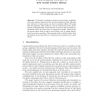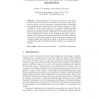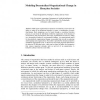ECAL
2007
Springer
13 years 8 months ago
2007
Springer
We identify two distinct themes in social science modelling. One, more specific, approach is that of social simulation which addresses how behaviour of many actors can lead to emer...
ECAL
2007
Springer
13 years 8 months ago
2007
Springer
This paper presents computer simulations which investigate the effect that different group sizes have on the emergence of compositional structures in languages. The simulations are...
ECAL
2007
Springer
13 years 8 months ago
2007
Springer
Abstract. Artificial selection of microbial ecosystems for their collective function has been shown to be effective in laboratory experiments. In previous work, we used evolutionar...
ECAL
2007
Springer
13 years 8 months ago
2007
Springer
Often the selfish and strong are believed to be favored by natural selection, even though cooperative interactions thrive at all levels of organization in living systems. Recent em...
ECAL
2007
Springer
13 years 8 months ago
2007
Springer
odel of Embodiment on Abstract Systems: from Hierarchy to Heterarchy Kohei Nakajima, Soya Shinkai, Takashi Ikegami A Behavior-Based Model of the Hydra, Phylum Cnidaria Malin Aktius...
ECAL
2007
Springer
13 years 10 months ago
2007
Springer
Agency detection is studied in a simple simulated model with embodied agents. Psychological experiments such as double TV-monitor experiments and perceptual crossing show the centr...
ECAL
2007
Springer
13 years 10 months ago
2007
Springer
Multi-agent organizations in dynamic environments, need to have the ability to adapt to environmental changes to ensure a continuation of proper functioning. Such adaptations can b...
ECAL
2007
Springer
13 years 10 months ago
2007
Springer
We introduce a new variant of the dissipative particle dynamics (DPD) model that includes the possibility of dynamically forming and breaking strong bonds. The emergent reaction ki...
ECAL
2007
Springer
13 years 10 months ago
2007
Springer
ECAL
2007
Springer
13 years 10 months ago
2007
Springer
Abstract. This paper investigates the processes used by an evolved, embodied simulated agent to adapt to large disruptive changes in its sensor morphology, whilst maintaining perfo...



